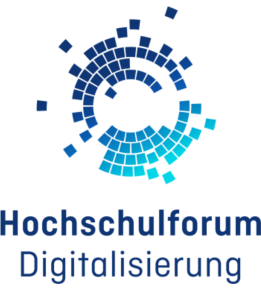Dimensions and fields of action for higher education in the digital age

1. strategy
Universities must address their sustainable development and profile building as part of overarching strategies. Digitization can be part of overarching strategies that go far beyond this single aspect and rather focus on synergies of different priorities. Digitization can often be harnessed in a particularly constructive and productive way if it is seen as part of overarching strategies and thus serves to raise the profile of the university as a whole.
Formulating the right goals for one’s own university and deriving a narrative from them is an important element in the further development of study & teaching. Defining independent objectives for digitization in teaching and learning can also be helpful at universities. Such strategic goals for digitization in teaching and learning must therefore be clearly formulated, prioritized, and communicated. This requires a clear understanding within the university of what is meant by “digitization in teaching and learning. Building on this, for example, a mission statement for teaching in the digital age can set a guiding framework at the level of the entire university. The derivation of short-, medium-, and long-term measures at all levels of the university can also be supported by a guiding framework for the further development of digitally supported teaching, from which the faculties/departments can derive specific goals and measures.
Particularly in the context of digitization, collaborations are the key to successfully shaping the digital transformation, expanding existing forms of cooperation and developing new offerings. Cooperations can be established with other universities as well as with non-university actors in order to expand the university’s own offerings.
Research is also increasingly playing a strategic role in the further development of studying & teaching in the digital age. In the sense of real laboratories, innovative approaches from research projects can and should be tested and implemented directly in teaching.
2. structure
For the further development of higher education in the digital age, the dovetailing of top-down and bottom-up processes through clear responsibilities as well as sustainable decision-making structures and participation opportunities is essential. In addition to the commitment of the university management by actively shaping strategic development, the university must establish sustainable decision-making structures between the university management and the faculties/departments for this purpose, as well as define responsibilities at the various levels. It is important that a sustainable continuation of strategy development and implementation is ensured even in the event of personnel changes, especially in university management, through role descriptions that are detached from individuals. In addition, all status groups as well as the central institutions and administrative offices responsible for teaching and learning should be involved in the development of the strategy as far as possible and in line with requirements.
For the digital transformation in higher education to succeed, sufficient human and financial resources must be made available on a sustainable basis. Financing is to be secured in the interaction of university management and faculties/departments through sustainable financial planning. For smaller universities in particular, this can also be made possible through collaboration with other universities by developing and using a common infra and support structure.
One field of action for shaping the digital transformation is the existence of an appropriate technical infrastructure: Beyond nationwide broadband connections and well-functioning WLAN equipment, the availability of modern hardware and software solutions is crucial for realizing digital application and deployment scenarios. The development of meaningful technical infrastructures requires significant financial investments by the higher education institutions on the one hand, and a wise and sustainable selection of solutions on the other, which in particular take into account and enable synergies in the higher education structures and are aligned with strategic higher education development planning. In this respect, the development of technical learning infrastructures is a central task of strategic university management.
Effective and efficient support and advising services can be central to student success. Therefore, such offerings must also evolve strategically in line with the digital transformation. Particularly in the context of the digital transformation of teaching and learning, conducive framework conditions are also decisive for whether teachers and students use new formats, platforms, concepts, and tools. Inexperienced teachers in particular need reliably available media-didactic support from professional service institutions.
Universities should make bolder use of existing conducive legal frameworks in the states to encourage the use of new teaching and learning methods and the advancement of curricula. However, the use and production of digital media in teaching in particular is subject to great uncertainty with regard to the legal framework and possible consequences, for example with regard to copyright, data protection issues or capacity law. Universities have a special responsibility to ensure that legal certainty applies to all employees, but at the same time they should make productive use of the existing legal framework. This also means that university employees should be ensured access to the latest internal university information and legal opinions at all times and, if necessary, supplementary incentive systems should also be created for use. At the same time, the (further) development of studying & teaching for the digital age must also be subjected to structured quality and process management as a strategic issue. This includes, in particular, ensuring the same or equivalent quality standards for digital and traditional teaching and learning formats. On the other hand, quality management as an overall organizational task also includes monitoring the development status with regard to strategic goals and the continuous further development of framework conditions (e.g. infrastructure, services).
The spread of digitally supported forms of teaching, learning and examination is a key indicator of how broadly digitization has been integrated into teaching and learning. In order to enable and promote the demand-oriented implementation of digitally supported forms of teaching, learning and examination and the use of corresponding digital tools, the use of these formats and tools should be anchored accordingly in the study and examination regulations and module catalogs. In addition, it is desirable to promote continuous development of these activities. The strategic (further) development of study & teaching is always also about the development of a “study for the digital age”. This means, in particular, the teaching of appropriate cross-cutting and specialist skills. Different competencies for the digital age should accordingly be a cross-curricular component of curriculum development. To do this, the university must agree on competencies relevant to its target groups.
3. culture
Personnel development is an important lever for implementing a strategy for studying & teaching in the digital age. Universities should exploit the scope for personnel development to drive the digital transformation in teaching. This happens on the one hand through the consideration of the topic in appointment procedures and the expansion of corresponding further training offers for teachers as well as through the expansion of the personnel structure through science-supporting personnel (e.g. employees in media and didactics centers, instructional designers, etc.).
In the context of cultural change at universities, it is necessary to increase the acceptance of new teaching, learning and examination formats among many teachers and to motivate them to use appropriate formats in their own teaching. Therefore, higher education institutions must offer attractive incentive formats for the use of such innovative teaching, learning and assessment formats. Incentives can be created on the one hand by enhancing the reputation of digital teaching and involving teachers in decision-making processes. At the same time, monetary incentive structures play an important role. In addition, awards that are visible to the outside world can also be given as a sign of appreciation.
In order to achieve a broad-based integration of digital media in teaching and learning, the associated goals and measures must be communicated appropriately to the various status groups within the university.University employees must be informed both passively and proactively about technical solutions for use in teaching, corresponding support infrastructures, and incentive systems. This means that information is provided in general and disseminated through various internal communication channels within the university.
If the introduction and implementation of digital learning environments is to have a lasting effect, teachers should be persuaded to do something that they are not initially obliged to do: change their teaching habits (for example, from a lecturing to a supportive teaching style), try out new electronic forms of examination, prepare courses for the longer term in cooperation with external bodies if the learning resources are made available via a learning platform – especially as this makes the teachers’ actions more transparent to outsiders. On the part of the university, starting with the university management, innovative spaces and solutions must therefore be created that initiate cultural change processes in a supportive manner.
Contact
 Barbara Wagner
Barbara Wagner
 Jannica Budde
Jannica Budde
 Aline Röttger
Aline Röttger
 Malu Amanda Dänzer Barbosa
Malu Amanda Dänzer Barbosa
